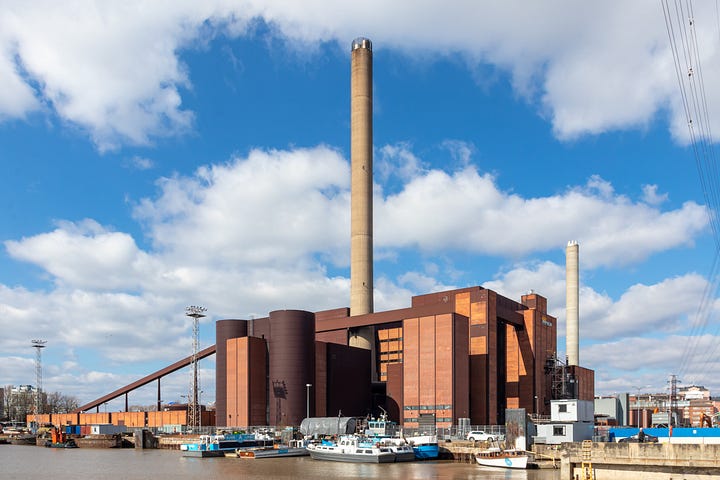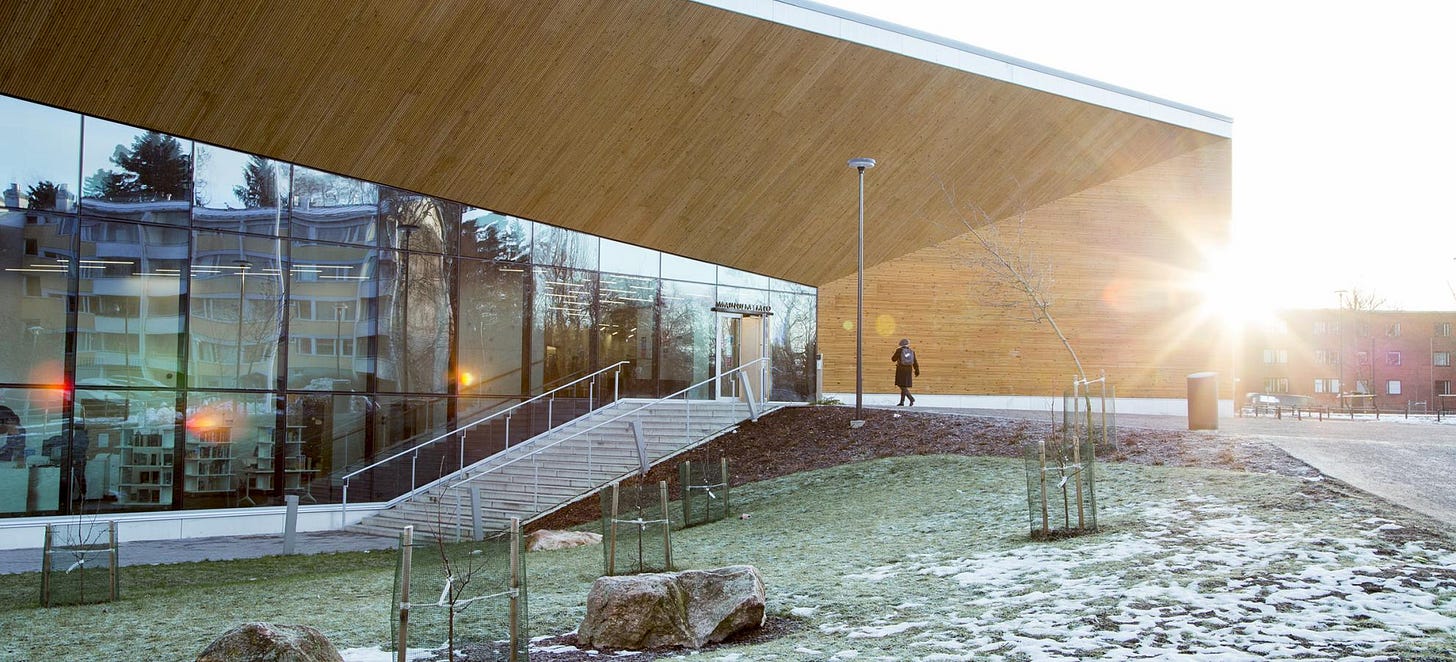Helsinki Pride
The capital of the happiest country in the world released its strategy proposal for 2025-2029. Helsinki's wants to be a city residents are proud of by investing in children and neighborhoods.
It is probably, or surely, a sign of being a policy nerd that you are beyond excited to dive into a city’s strategy proposal. The City of Helsinki released the political negotiation result for its strategy yesterday. While the proposal still requires City Council approval in August, the fact that the paper is a result of a five-party negotiation, means that it is pretty much set.
Governance by Consensus
Helsinki, like all Finnish municipalities, are governed by multiple parties together. No political party has a clear majority so collaboration and some level of negotiation is always needed for getting things done.
The City of Helsinki is a massive organization responsible for urban planning, education, social and health care as well as culture and leisure. With nearly 40,000 employees it is also the largest employer in the country.
Municipalities have a legal responsibility to adopt a four-year strategy. I worked for Helsinki 2012-2021 and took part in numerous strategy processes as a civil servant. Our role was to provide information and make suggestions for the negotiations between political parties in June, right after the municipal elections.
As the goal is to have all or at least most political parties support the strategy, there is a need to make sure that the priorities of most parties are met to a sufficient level. This often results in a difficulty in making clear choices. Easily, the strategy ends up covering all areas of the municipality’s work and becoming more a description of responsibilities than a priority list. As the strategy is approved separate from the budget and all parties need to demonstrate to their constituency that they have had impact, the strategy is usually bursting with goals to increase and grow services and improve delivery. According to the 5,200-word strategy proposal, Helsinki is striving to do a lot more things while being far less vocal on what it does less.
Aspiration: A Helsinki we can be proud of
Helsinki’s aspiration is coined in the title of the strategy:
A Helsinki we can be proud of
In the press announcement and in the publication event, Helsinki’s new Mayor Daniel Sazonov did not go into detail explaining the idea behind the slogan but linked it to two ideas:
Helsinki needs its residents and partners to build a city we can be proud of.
The strategy prioritizes children and youth.
Helsinki’s two previous strategies were titled ‘Most Functional City in the World’ and ‘A Place for Growth’. I read the new strategy as an ambition for a municipal culture that embraces diversity and recognizes that a good city is not one-size-fits-all. The strategy also seems to emphasize that the city cannot create a great place to live or run a business alone. This goal of collaboration is articulated several times, for instance by saying that the border between public and private is artificial for many residents and for their wellbeing.
I did my thesis in Political Science on the language of government policy documents. Reading the document through the lens of rhetorics, I do wonder how intentional it is that the chosen wording (a city we can be proud of) leaves it fairly open how far or close we are to the goal, versus for instance saying ‘a city we are proud of’. Starting from the title, it is not exactly clear if the strategy is one of radical reform or one of sustaining current status.
This question is important for a city that has had global acclaim for its livability while being the capital of the second fastest aging country in the world. Helsinki is the capital of a country influenced heavily by current geopolitics and where the economy has not been growing as fast as many of its neighbors. Due to its legacy of quality education, social welfare and happiness, Finland sometimes gets stuck in a fear of falling when thinking about the challenges ahead.
Having said that, the strategy title does present an opportunity for recognizing residents’ feeling and pride of their city as a credible data point to assess local government’s performance. When we are proud of something, we are willing to work hard for it and make sacrifices and collaborate with others for the common good. It would be fascinating if Helsinki would track this sense of pride through quantitative and qualitative research.
Taking Cozy, Beautiful and Distinct Seriously
The strategy proposal has five core areas:
Neighborhoods
Wellbeing
Daily Life and Service Delivery
Urban development
Growth
What strikes me as a fresh take is the emphasis on neighborhoods. Helsinki is a massive service delivery system with only one political decision making level. Its service delivery divisions have more staff than most Finnish municipalities have residents. (For context, I ran the smallest division with 1,800 employees.) As a result, Helsinki has traditionally struggled with combining people’s place-based reality and the city’s function-based organization. The choice to talk about neighborhoods seems far more human-centered - and something I see often in U.S. cities where you often even have a Department of Neighborhoods.
The proposal provides an opportunity to rethink about the levers of urban development. What excites me in this articulation is that the proposal takes issues like neighborhood character, positive differentiation, urban greenery, public spaces, public works, public-private collaboration - even beauty - seriously. As an example, the city is launching A More Beautiful Helsinki program focused on architectural quality! They talk about cleanliness of streets and nature in the built environment. They are planning to double investments to public art and find more working spaces for artists and creatives across the city. They talk about supporting civil society and community events. It seems that Helsinki understands that if you want people to walk, cycle, use public transportation and convene more, their living environment cannot only be functional but it has to be clean, cared for, safe and provide experiences of belonging, awe and wonder.
Reading the document, it is not clear, however, how this support of character and the city’s ambition for needs-based investment into low-income neighborhoods coincide. If Helsinki is serious about collaboration and positive differentiation, the strategy opens a door for new funding, co-governance and maintenance models. It opens opportunities to look at the development of neighborhoods from an asset-based perspective. But it also poses a risk where neighborhoods with resources get their projects moving faster with public-private-people models while low-income neighborhoods are subjects to problem-focused, top-down solutions. If Helsinki is serious about its ambition on neighborhoods, its participation and engagement models need to be revised to reflect this ambition of understanding what people value in their neighborhoods. At its best, the strategy can open opportunities for collaborative governance, resident-led planning, public-private solutions, land trusts and so forth. (Full disclaimer: I played a key role in the development of the current participation and engagement model, resulting in the launch of participatory budgeting.)
Opportunities for Urban Innovation
The strategy continues the focus on the so-called urban reform areas, which have historically been underinvested and score lower on most socio-economic indicators.
In addition to them, the strategy highlights two opportunities for urban innovation. Helsinki closed its last coal plant in the middle of the city two years ago. The strategy proposes an international design competition for the future of this massive site in the middle of the city. This is an incredible opportunity to rethink public space and explore new collaboration models. The Hanasaari power plan is a historically significant, architecturally distinct area in the middle of the city. It could be a phenomenal place. Helsinki recognizes the opportunities of temporary use while developing


Helsinki has also identified the need to develop the areas around the main railway that split its downtown in half. This ambition is articulated in a way I have never heard during my nearly ten years in city leadership. This is an incredibly opportunity for tactical experimentation, international collaboration and real resident engagement in a way that changes the way we think about connection and proximity.
Capital of Literacy
Finland has a reputation of having one of the best education systems in the world. Having said, the last few years have shown drops in learning results, especially for boys.
The strategy highlights the importance of graduating from basic education with a level of reading, writing, calculating and general knowledge that sets you for success. Helsinki sets a goal to make class sizes smaller for small children and increase hours on language and literacy. The city recognizes the importance of maternity clinics and libraries in literacy.
I love the idea that Helsinki strives to be the capital of literacy and links this aspiration to optimism, passion and success.
How is Helsinki Getting There?
The strategy proposal reads as a Finnish combination of pragmatism, humanism and optimism. It includes five foundations for the city’s success:
Economy
Nature and Climate
Personnel and Leadership
Safety and Preparedness
Advocacy and International Relationships
It takes a fresh and non-ideological tone on collaboration, which probably is a result of negotiations between conservative and leftish fractions in the City Council.
When the proposal mentions collaboration, the stakeholders mentioned are the private sector, civil society, the national government, universities and arts organizations. It is worth noting that the strategy has no mentions of Helsinki’s neighboring cities in the capital region. Maybe the years of working with American cities make me pay attention to the fact that the strategy has no mentions of faith communities, religion or faith.
Looking at the world we live in and Finland’s geopolitics, it is understandable that the section on safety is beefed up compared to previous strategies. The proposal includes mentions of strengthening civil protection and supporting resident preparedness.
When it comes to safety and preparedness, the strategy does seem to miss an opportunity to create an explicit link between safety and preparedness and social cohesion and a sense of belonging. This might be so obvious to Finns that you don’t even mention it. If we meet in public spaces and public transportation, if we have vibrant and free civil society, if we know people from different walks of life, if we have shared experiences across differences, we are smarter, kinder and more resilient also in times of crisis.
In a similar fashion, the strategy might have benefited from an explicit links between tourism and the aspired investments into neighborhood character. If we are proud of our distinct neighborhoods, the city is also more interesting to visitors.
Overall, connecting the different parts of the strategy to each other would support both stakeholders and city staff see their work in a larger framework and seek new collaborations.
Most of my work is on public innovation. Looking at the strategy through that lens, I do notice that strategy has only one mention of trying something out (entrepreneur model for doctors). There isn’t a lot of recognition of uncertainty, unpredictability and risk taking. While Helsinki sets goals for productivity, it has categorically ruled out changes in its leadership and governance model. The three mentions of innovation are limited to support for others (creatives, businesses) rather than innovations in government and services. The section on personnel and leadership focuses on the right to good leadership, job protection, professional development and supporting good performance but has no mentions of incentives for innovation, experimentation or productivity. The part on international relationship has a strong emphasis on visibility, role and attractiveness and is less explicit on learning from and with other cities.
Having said all that, I am excited by Helsinki’s future. There is something fresh and hopeful about neighborhoods, childhood and collaboration. Over the next year, I will be taking several, mostly American groups to this city I absolutely love. The strategy reads as a detailed enough roadmap of a city that is not afraid of the future. It knows who it is and what makes it Helsinki.












Thank you Tommi for a sharp analyse! Reading the paper made also me feel optimistic and enthusiastic, feelings so rare in today’s politics. (My 10 takes in Finnish in my latest post).